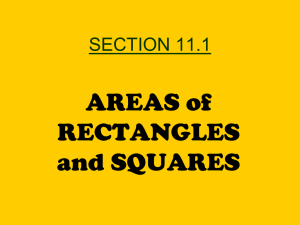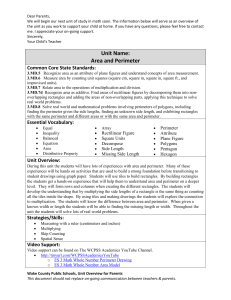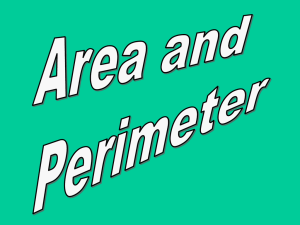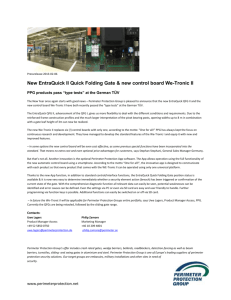DOC - National Capital Authority
advertisement
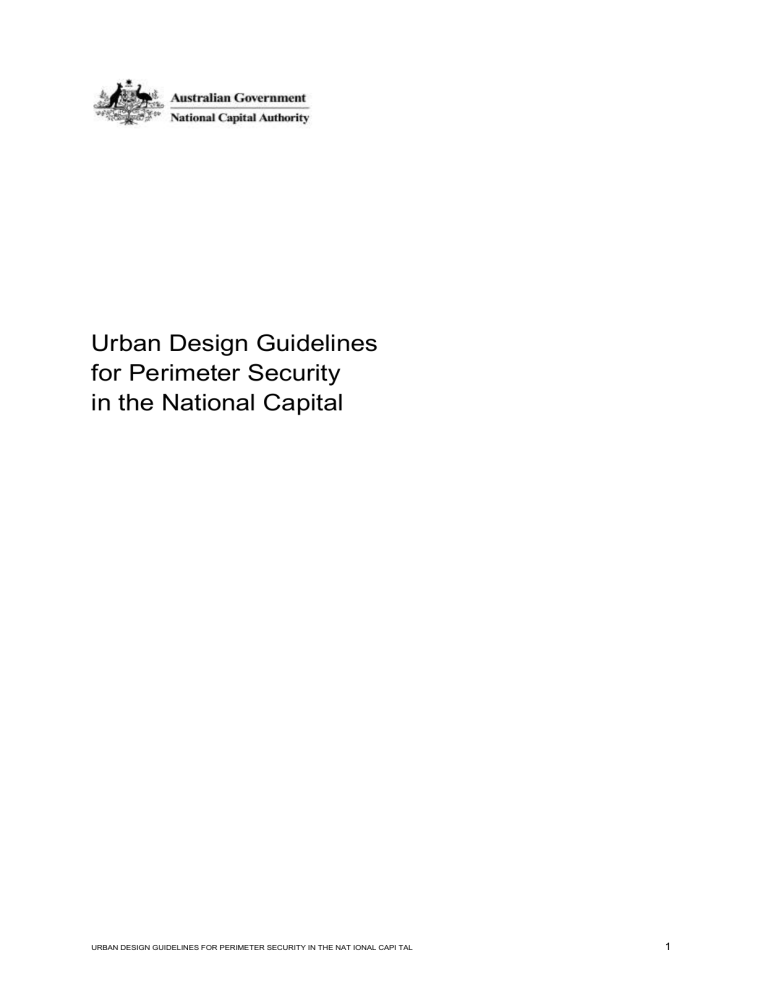
Urban Design Guidelines for Perimeter Security in the National Capital URBAN DESIGN GUIDELINES FOR PERIMETER SECURITY IN THE NAT IONAL CAPI TAL 1 Urban Design Guidelines for Perimeter Security in the National Capital © Crown Copyright 2003 National Capital Authority Printed May 2003 Disclaimer Any representation, statement, opinion or advice, expressed or implied in the publication is made in good faith and on the basis that the Commonwealth of Australia, its agents and employees are not liable (whether by reason or negligence, lack of care or otherwise) to any person for any damage or loss whatsoever which has occurred or may occur in relation to that person taking or not taking (as the case may be) action in respect of any representation, statement or advice referred to above. URBAN DESIGN GUIDELINES FOR PERIMETER SECURITY IN THE NAT IONAL CAPI TAL 2 Contents 1. Introduction .......................................................................................................................................................... 5 1.1. The National Capital Authority ...................................................................................................................... 5 1.2. Purpose of Guidelines ................................................................................................................................... 6 1.3. Specific Areas covered by Guidelines ........................................................................................................... 6 2. Objectives of the Guidelines ................................................................................................................................ 7 3. Using the Guidelines ........................................................................................................................................... 8 4. Security Performance .......................................................................................................................................... 9 4.1. Stand-off Distances ....................................................................................................................................... 9 4.2. Security Zones .............................................................................................................................................. 9 5. Urban Design Framework and Streetscape Security ..........................................................................................13 5.1. Street Types.................................................................................................................................................13 5.2. Context.........................................................................................................................................................14 5.3. Urban Design Frameworks ..........................................................................................................................16 5.4. Urban Design and Security Concept Plans ..................................................................................................19 5.5. Suite of Security Responses ........................................................................................................................21 Reference List ........................................................................................................................................................30 URBAN DESIGN GUIDELINES FOR PERIMETER SECURITY IN THE NAT IONAL CAPI TAL 3 List of figures Figure 1: Hastily erected jersey barriers at the Russell Defence precinct, Canberra ............................................... 5 Figure 2: Parliamentary Zone, Barton and York Park, and Russell ......................................................................... 6 Figure 3: Indicative stand-off concept ...................................................................................................................... 9 1 Figure 4: Streetscape security element suite (NCPC, 2002 ) .................................................................................10 2 Figure 5: Security elements in urban areas (NCPC, 2002 ) ...................................................................................10 Figure 6: Security zones .........................................................................................................................................11 Figure 7: Building Grounds zone ............................................................................................................................11 Figure 8: Verge/footpath zone ................................................................................................................................12 Figure 9: The Parliamentary Zone ..........................................................................................................................14 Figure 10: Barton and York Park ............................................................................................................................15 Figure 11: Russell...................................................................................................................................................16 Figure 12: ACT Magistrates Court is built to the edge of Knowles Place with a broad paved verge.......................17 Figure 13: Kings Avenue, Barton – a landscape street...........................................................................................17 Figure 14: The High Court of Australia, Parkes located in a park setting ...............................................................18 Figure 15 (a): Parliamentary Zone ..........................................................................................................................19 Figure 15 (b): Barton and York Park .......................................................................................................................20 Figure 15 (c): Russell current .................................................................................................................................21 Figure 15 (d): Russell future ...................................................................................................................................21 Figure 16: Suite of Security Elements ....................................................................................................................22 Figure 17: Security Elements Matrix .......................................................................................................................27 URBAN DESIGN GUIDELINES FOR PERIMETER SECURITY IN THE NAT IONAL CAPI TAL 4 1. Introduction Australia is a strong and vigorous democracy, open and free. Australia’s capital, Canberra, symbolises and articulates national identity, achievement, aspiration and culture. It houses the major institutions, symbols and collections of federal parliamentary democracy, and the key agencies of national government. Australia has been on a heightened level of security alert since the terrorist attacks of 11 September 2001 in New York and Washington, and Bali in 2002. Detailed plans are in place for governments and security agencies to respond to terrorism, and governments are working with managers of critical facilities – including national institutions – to prepare plans for protection. Security and protection plans often require that vehicles are prevented from entering areas in or near critical infrastructure. The National Capital Authority has prepared these Urban Design Guidelines for Security in the National Capital to encourage high quality design solutions that integrate building security into the landscape of public areas. Figure 1: Hastily erected jersey barriers at the Russell Defence precinct, Canberra These Guidelines aim to protect Canberra’s democratic, welcoming and internationally renowned landscape and vistas while facilitating enhanced security. They demonstrate that a safe and secure urban environment can be created in ways that enhance rather than diminish the qualities of public spaces. They show alternatives to the temporary responses seen in other capitals and recently in Canberra. Ad hoc measures such as hastily erected barriers more suited to protecting temporary road works, concrete planter boxes discordant with surrounding landscape, guard huts marking main entrances, and unco-ordinated road closures mar beauty, detract from symbolism, and reduce the appearance if not the reality of freedom in our democratic society. The Australian Bomb Data Centre of the Australian Federal Police and Australian Security Intelligence Organisation (ASIO) have contributed to the development of these guidelines. 1.1. The National Capital Authority The National Capital Authority is established under the Australian Capital Territory (Planning and Land Management) Act 1988. URBAN DESIGN GUIDELINES FOR PERIMETER SECURITY IN THE NAT IONAL CAPI TAL 5 The National Capital Authority secures the Commonwealth’s continuing interest in the planning and development of the National Capital, and manages cultural landscapes and commemorative elements within significant national areas. The Authority’s vision is a National Capital which symbolises Australia’s heritage, values and aspirations, is internationally recognised, and worthy of pride by Australians. Its mission is to build the National Capital in the hearts of all Australians. 1.2. Purpose of Guidelines These Urban Design Guidelines for Perimeter Security in the National Capital provide design solutions for building perimeter security with a suite of elements that enhance streetscapes and building settings. The Guidelines recognise that effective defences against terrorist attack includes multiple layers of security, extending from such measures as enhanced airport security through to building design and the management of access to sensitive precincts and buildings. The Guidelines address protection from vehicle-borne threats, and promote physical measures that can be taken within or adjacent to building grounds to provide protection from vehicles without detriment to the amenity of public areas. They do not address threats which may be posed by pedestrians, air attack, or chemical or biological weapons. 1.3. Specific Areas covered by Guidelines The Guidelines focus on specific areas for which the National Capital Authority has land management responsibility or for which it must provide works approval. These include: the Parliamentary Zone; the Russell Defence precinct; and Barton (including York Park). Within these areas there is a range of nationally significant government buildings and complexes such as Parliament House, the Defence Headquarters and the High Court of Australia. The Guidelines can also be applied to other locations where security is required such as the diplomatic estates. Figure 2: Parliamentary Zone, Barton and York Park, and Russell URBAN DESIGN GUIDELINES FOR PERIMETER SECURITY IN THE NAT IONAL CAPI TAL 6 2. Objectives of the Guidelines The objectives of the Guidelines include: provision of appropriate perimeter security for sensitive buildings against vehicle-born threats; integration of security with streetscape elements, rather than having separate fixtures whose only purpose is security; a suite of structural and landscape features that provide perimeter security while maintaining excellence in urban design; a coherent strategy, guided by the Authority, through which security is achieved without sacrificing urban design quality; perimeter security without compromise to the National Capital’s commerce or vitality, pedestrian or vehicular mobility; and assurance that landscape and streetscape treatments or structures do not detract from heritage values. URBAN DESIGN GUIDELINES FOR PERIMETER SECURITY IN THE NAT IONAL CAPI TAL 7 3. Using the Guidelines All works undertaken in the Parliamentary Zone, Russell and Barton (including York Park) require the approval of the National Capital Authority. While the Guidelines are intended to apply to these areas they may also be used in other locations in the Territory or in other cities or sensitive locations where improved security is required. These Guidelines provide: Guidance for Commonwealth agencies, cultural institutions or private sector building owners seeking to improve security measures for their buildings; Guidance for public and privately funded security works within public areas, including streetscape and local area traffic works; A decision-making framework for the Authority when considering approval of these works. In areas where the Authority has responsibility for works approval the following process is recommended: Initial Application Agencies and institutions should have preliminary discussions with the Authority to ensure appropriate scoping of work, prior to briefing their nominated designers Sketch Designs Designers and client agencies/institutions should submit preliminary designs for comment before proceeding with design development Detailed drawings should be submitted later for more detailed assessment and to gain 'support in principle' before a formal works approval application and construction documentation is prepared Works Approval Application Formal application lodged with supporting documents and three sets of working drawings URBAN DESIGN GUIDELINES FOR PERIMETER SECURITY IN THE NAT IONAL CAPI TAL 8 4. Security Performance 4.1. Stand-off Distances Stand-off distance is critical in perimeter security design. The distance will normally be the distance between the building and the nearest point to which unauthorised vehicles have access. Larger standoff distances offer greater protection. Most buildings in the Parliamentary Zone and Barton are well set back from streets. In the Parliamentary Zone, buildings are generally freestanding in a parkland setting. However, in the Russell Defence precinct, buildings are closer to streets and parking areas. The wide avenues and clear streets of central Canberra may allow unimpeded approach at high-speed to barriers serving as building-perimeter protection. In these cases, travel speeds may be restricted by modifying approaches to the barriers, or the barriers will have to be designed to have sufficient strength to stop heavy vehicles travelling at speed. Buildings can be strengthened to enhance security and blast resistance. This depends on the structural characteristics of each building and is outside the scope of these Guidelines. Figure 3: Indicative stand-off concept 4.2. Security Zones Security zones between building and streets include the building grounds, the verge/footpath and the kerb or parking lane. Most measures are implemented either within the building grounds or in the verge/footpath zone. Design of streetscapes and landscapes is intended to establish or reinforce distinctive urban character and improve amenity. Building perimeter security should be incorporated into the streetscape or landscape design. A number of elements are proposed including lights, walls, plinths, fences, planters, seats, trees, hedges and bollards, all of which can be appropriately strengthened or supplemented to serve as physical barriers to vehicles while improving the amenity of public spaces. Some solutions may be suitable in all areas; others are appropriate only in particular settings. Figures 4 and 5 illustrate a suite of security elements developed by the National Capital Planning Commission for Washington. The Washington elements are generally applicable to its urban areas. Canberra needs elements designed to suit the unique character of its streets and precincts. URBAN DESIGN GUIDELINES FOR PERIMETER SECURITY IN THE NAT IONAL CAPI TAL 9 1 Figure 4: Streetscape security element suite (NCPC, 2002 1) 2 Figure 5: Security elements in urban areas (NCPC, 2002 2) (a) Building grounds Building grounds between the footpath and the building typically consist of lawn and trees or shrubs. Entry paths and roads cross these areas. Security measures within the building grounds should complement the architecture and landscape design. In most cases, where buildings are set back from their front property boundary the security measures should be located near the outer edge of the grounds. A typical solution could be a barrier designed as a raised plinth or wall, keeping the footpath and verge free of security elements. 1 1 & 2 National Capital Planning Commission (NCPC). 2002. Draft National Capital Urban Design and Security Plan. National Capital Planning Commission: Washington DC 2 1 & 2 National Capital Planning Commission (NCPC). 2002. Draft National Capital Urban Design and Security Plan. National Capital Planning Commission: Washington DC URBAN DESIGN GUIDELINES FOR PERIMETER SECURITY IN THE NAT IONAL CAPI TAL 10 Figure 6: Security zones Figure 7: Building Grounds zone (b) Verge/footpath The footpath/verge zone is located between the block boundary and the kerb. In most cases, the footpath/verge serves as the common space for interaction, movement and activity. To the greatest extent possible, verges and footpaths should be left open and freely accessible for pedestrian movement. Security elements should be placed close to the kerb while allowing car doors to open and pedestrian movement from the car to the footpath. Parking meters, streetlights, benches, planters, and garbage bins are familiar elements found at or near the kerb. Strengthened versions of these could be designed to enhance perimeter security. URBAN DESIGN GUIDELINES FOR PERIMETER SECURITY IN THE NAT IONAL CAPI TAL 11 Figure 8: Verge/footpath zone (c) Kerb/parking lane Parking, passenger drop-off, cycling, bus stops, taxi ranks, and loading zones are often in the kerbside lane. Kerbside parking should be removed only as a last resort where the need for additional secure distance is required for buildings requiring the highest levels of security. Before kerbside parking is removed, the parking needs of the area and adjacent buildings should be assessed and adequate replacement parking provided. URBAN DESIGN GUIDELINES FOR PERIMETER SECURITY IN THE NAT IONAL CAPI TAL 12 5. Urban Design Framework and Streetscape Security The Parliamentary Zone, Barton and York Park, and the Russell Defence precinct are three distinctive zones – each with unique urban design characteristics – in which there is a recognised need for perimiter security. Within these zones, the characteristics of three distinct types of street – main avenues, connector streets and local streets – guide the formation of design principles. 5.1. Street Types Generally, each street has some common characteristics, including the widths of carriageways and verges or footpaths. Other aspects, such as the relationship of buildings to the street, may vary along the length of a street. Each street – especially each main avenue – is a unified, continuous and coherent space; design should emphasise the whole rather than the parts. (a) Main avenues Main avenues connect and define the most important parts of the city. Commonwealth Avenue, Kings Avenue and Constitution Avenue (which define the National Triangle), Brisbane Avenue, State Circle and Sydney Avenue are examples of main avenues. The avenues frame vistas to buildings, monuments and landscapes that symbolise the National Capital and the importance of the Seat of Government. (b) Connector streets Connector streets have particular spatial qualities, provide access from main avenues to important national buildings, monuments and landscapes, and link major avenues. King Edward Terrace, King George Terrace, National Circuit and Macquarie Street are examples of connector streets. (c) Local streets The function of local streets is confined to providing direct access to specific sites. Blackall Street and Parkes Place are examples of local streets. URBAN DESIGN GUIDELINES FOR PERIMETER SECURITY IN THE NAT IONAL CAPI TAL 13 5.2. Context (a) Parliamentary Zone Figure 9: The Parliamentary Zone Parliamentary Zone Principles The Parliamentary Zone is the symbolic heart of the National Capital and is at the geometric centre of the Walter Burley Griffin Plan for Canberra. The Federal Parliament on Capital Hill, together with Federation Mall and Old Parliament House, place the Parliamentary Zone at the centrepoint of Australian government. As envisaged by the founders of the Capital, the Zone represents the physical manifestation of the seat of Commonwealth Government under the Australian Constitution – a Government empowered by a free people. It is also the home to the nation’s most important cultural and government institutions. The Parliamentary Zone Master Plan in the National Capital Plan guides development in the Zone. The Statement of Principles in the Master Plan require that: The Parliamentary Zone will be given meaning as the ‘place of the people,’ accessible to all Australians so that they can more fully understand and appreciate the collective experience and rich diversity of this country. To do this, the place of the people must reflect: The political and cultural role of Australia’s Capital; Federation and Australian democracy; The achievements of individual Australians in all areas of endeavour; The diversity of Australia, its peoples, natural environments, cultures and heritage; and The unique qualities of Australian creativity and craftsmanship. The place of the people must have: A sense of scale and dignity and openness; A cohesive and comprehensible layout; URBAN DESIGN GUIDELINES FOR PERIMETER SECURITY IN THE NAT IONAL CAPI TAL 14 A large forum for public ceremony and debate; Intimate, enjoyable spaces for individuals and groups; A dynamic program of national, state and regional events; and Public facilities that are accessible and affordable. (b) Barton and York Park Figure 10: Barton and York Park Barton and York Park occupy a prominent site in the Central National Area and contribute to the urban form and landscape features that give the National Capital its special character and setting. These areas provide part of the backdrop and approaches to Parliament House and form the eastern edge to the National Triangle. Barton and York Park assume a key role in the daily functions of government, providing prestigious sites for major government departments and headquarters of major national associations. Through the role of departments and associations based in Barton and York Park receiving visiting officials and dignitaries, the area has a significant international profile. Kings, Brisbane and Sydney Avenues and State Circle and National Circuit provide main address points. Windsor Walk provides a secondary address and set-down point. URBAN DESIGN GUIDELINES FOR PERIMETER SECURITY IN THE NAT IONAL CAPI TAL 15 (c) Russell Figure 11: Russell The Russell Defence precinct is an area of special national significance, located at the northeastern apex of Griffin’s National Triangle. Occupying a magnificent setting between Lake Burley Griffin and the inner hills, Russell acts as a counterpoint to the city centre of Civic and is visible from a number of important vantage points. The main access routes are Kings Avenue, Parkes Way, Morshead Drive, Constitution Avenue, and Northcott Drive. Russell houses the headquarters of the Australian Defence Forces and is an integral part of the physical and symbolic network of defence-related institutions that include the Australian War Memorial, Campbell Park Offices, the Australian Defence Force Academy and the Royal Military College, Duntroon. 5.3. Urban Design Frameworks Perimeter security should reinforce the existing or intended streetscape character and setting for buildings. Some characteristics of streets may vary along their length. In areas of the Parliamentary Zone, some buildings are located in park-like settings (eg the National Gallery). In areas of Russell, and Barton and York Park, buildings are located closer to the street and the character is more urban. This urban design framework identifies the existing or future streetscape character in the following broad categories: URBAN DESIGN GUIDELINES FOR PERIMETER SECURITY IN THE NAT IONAL CAPI TAL 16 (a) Urban streets In urban streets, buildings are built close to street boundaries and generally frame the street. There is typically more pedestrian activity in urban streets and, consequently, verges contain broad paved footpaths. Figure 12: ACT Magistrates Court is built to the edge of Knowles Place with a broad paved verge. (b) Landscape streets In landscape streets, buildings are generally located further back from the street and the landscape is the dominant element. While the foreground of buildings is generally grass, trees and hedges, the buildings have a direct relationship to the street and provide a degree of enclosure to it. Figure 13: Kings Avenue, Barton – a landscape street URBAN DESIGN GUIDELINES FOR PERIMETER SECURITY IN THE NAT IONAL CAPI TAL 17 (c) Park setting Park settings are where buildings are located in a park-like setting and have little relationship with the street. The emphasis of urban design in perimeter security for buildings in a park setting is to reinforce the scenic landscape qualities of the setting of the buildings. Figure 14: The High Court of Australia, Parkes located in a park setting URBAN DESIGN GUIDELINES FOR PERIMETER SECURITY IN THE NAT IONAL CAPI TAL 18 5.4. Urban Design and Security Concept Plans The existing or intended character of the Parliamentary Zone, Barton and York Park, and the Russell Defence precinct has been mapped using the categories of urban street, landscape street or park setting. This is shown in Figures 15 a, b, c and d. Figure 15 (a): Parliamentary Zone URBAN DESIGN GUIDELINES FOR PERIMETER SECURITY IN THE NAT IONAL CAPI TAL 19 Figure 15 (b): Barton and York Park URBAN DESIGN GUIDELINES FOR PERIMETER SECURITY IN THE NAT IONAL CAPI TAL 20 Figure 15 (c): Russell current Figure 15 (d): Russell future 5.5. Suite of Security Responses A suite of perimeter security elements has been prepared for each of the settings (fig.16). Some elements, such as bollards and raised planters, are suitable for use in all settings, whereas others are appropriate only in specific locations. Existing examples of some elements are shown in Figure 16. These can be used or adapted for a specific streetscape or security project. URBAN DESIGN GUIDELINES FOR PERIMETER SECURITY IN THE NAT IONAL CAPI TAL 21 Figure 16: Suite of Security Elements Raised Planter This element is suitable in Urban, Landscape and Park settings Bollards and Flagpole Suitable in Urban, Landscape and Park settings Stone Bollards Suitable in Urban, Landscape and Park settings Plinth wall and ramp Suitable in Urban, Landscape and Park settings URBAN DESIGN GUIDELINES FOR PERIMETER SECURITY IN THE NAT IONAL CAPI TAL 22 Figure 16: Suite of Security Elements (continued) Chamfered low wall with street name Suitable in Landscape and Park settings Massive bollards Suitable in Urban, Landscape and Park settings Drainage Depression Suitable in Park settings Low Plinth Wall Suitable in Urban, Landscape and Park settings URBAN DESIGN GUIDELINES FOR PERIMETER SECURITY IN THE NAT IONAL CAPI TAL 23 Figure 16: Suite of Security Elements (continued) Streetlight With Concrete Base Suitable in Urban, Landscape and Park setting Line of Elements Suitable in Urban settings Low Wall in Planting Seating Suitable in Landscape and Park settings Seating Suitable in Park settings URBAN DESIGN GUIDELINES FOR PERIMETER SECURITY IN THE NAT IONAL CAPI TAL 24 Figure 16: Suite of Security Elements (continued) Bollard Seats Suitable in Urban, Landscape and Park settings Large Planter Pots Suitable in Urban settings Park Fence Suitable in Urban, Landscape and Park settings Seating in Low Wall Suitable in Urban, Landscape and Park settings URBAN DESIGN GUIDELINES FOR PERIMETER SECURITY IN THE NAT IONAL CAPI TAL 25 Low Wall With Building Name Suitable in Landscape and Park settings Bollard and Fence Suitable in Urban, Landscape and Park settings URBAN DESIGN GUIDELINES FOR PERIMETER SECURITY IN THE NAT IONAL CAPI TAL 26 Figure 17: Security Elements Matrix Situation Urban streetscape Security Elements Suite of hardened streetscape elements: bollards bollard & chain seats raised planter street lights bins plinth wall bus shelter bicycle racks large planter pots street trees Location Adjacent to kerb line keeping generous clear footpath area for pedestrian movement. Generally no closer than 1.5m from kerb line to allow car doors to open. Adjacent to kerb URBAN DESIGN GUIDELINES FOR PERIMETER SECURITY IN THE NAT IONAL CAPI TAL 27 Situation Landscape streets Security Elements Suite of elements: raised planter bollards hedges bollards in planting trees plinth wall low wall bus shelter Location On or adjacent the street/block boundary within the building grounds allowing sufficient openings to allow for pedestrians to enter buildings. Within the building grounds URBAN DESIGN GUIDELINES FOR PERIMETER SECURITY IN THE NAT IONAL CAPI TAL 28 Security Elements Matrix (continued) Situation Park Setting Security Elements Suite of elements: bollards mass tree planting hedges ha-ha wall garden wall raised planter masonry and metal picket fence Location In accordance with design for the park or building curtilage. URBAN DESIGN GUIDELINES FOR PERIMETER SECURITY IN THE NAT IONAL CAPI TAL 29 Reference List National Capital Planning Commission (NCPC). 2002. Draft National Capital Urban Design and Security Plan. National Capital Planning Commission: Washington DC National Capital Authority (NCA). Updated 2002. National Capital Plan – with amendments. National Capital Authority: Canberra. URBAN DESIGN GUIDELINES FOR PERIMETER SECURITY IN THE NAT IONAL CAPI TAL 30
